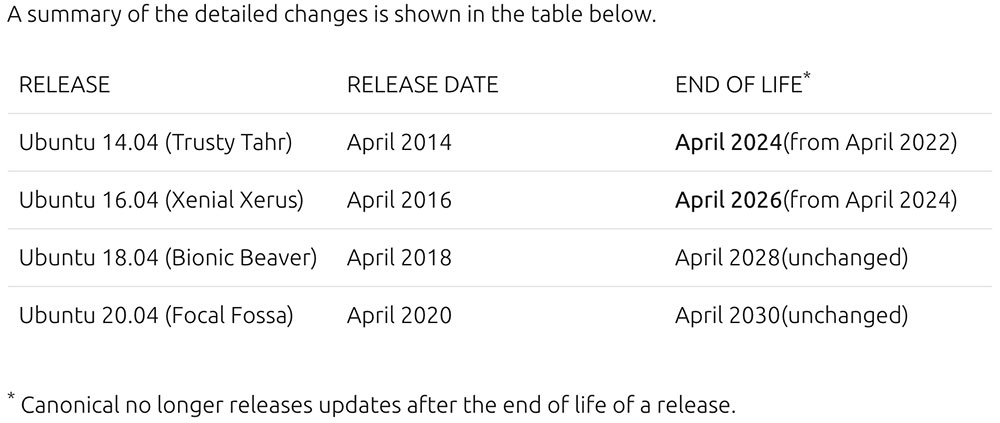Canonical on Sept. 21 announced the lifecycle extension of Ubuntu 14.04 LTS (Trusty Tahr) and 16.04 LTS (Xenial Xerus) to help organizations implement their transition to new applications and technologies.
This lifecycle extension enables organizations to balance their infrastructure upgrade costs. The support extensions give them additional time to implement their upgrade plan. The lifecycle extensions provide support for a total of 10 years.
Canonical’s Extended Security Maintenance (ESM) phase of Ubuntu 14.04 and 16.04 LTS enables a secure and low-maintenance infrastructure with security updates and kernel live patches.
The prolonged lifecycle of Ubuntu 14.04 LTS and 16.04 LTS turns a new page in Canonical’s commitment to enabling enterprise environments, according to Nikos Mavrogiannopoulos, product manager at Canonical.
“Each industry sector has its own deployment lifecycle and adopts technology at a different pace. We are bringing an operating system lifecycle that lets organizations manage their infrastructure on their terms,” he said.
Better Economics and Cybersecurity
Organizations have been putting significant effort and financial resources to phase out legacy systems. Those efforts have significantly increased IT budgets over the past three years, noted Canonical.
By prolonging the operating system lifecycle to 10 years, Canonical is helping organizations to better assess their IT budget in order to implement or plan their infrastructure upgrades.
Organizations are constantly being challenged by attackers taking advantage of vulnerabilities to gain access or deploy malware. Whatever cybersecurity framework organizations pick — ISO 27000, NIST, PCI, or CIS Controls, Ubuntu offers them an implementation path. ESM and kernel live patching provide the necessary foundation for continuous vulnerability management.
Extended Security Maintenance ensures that the Ubuntu OS receives security updates. The Livepatch service reduces the unplanned work that comes from Linux kernel vulnerabilities. This makes organizations more effective when managing Ubuntu systems.
A Boost From Base Offering
Ubuntu users can normally receive security updates for the Ubuntu base OS, critical software packages, and infrastructure components with Extended Security Maintenance. ESM provides five additional years of security maintenance, enabling an organization’s continuous vulnerability management.
ESM is available through an Ubuntu Advantage for Infrastructure subscription for physical servers, virtual machines, containers, and desktops. It is free for personal use.
Ubuntu Pro premium images are optimized for the public cloud. They provide security maintenance for high and critical Common Vulnerabilities and Exposures (CVE) for the entire collection of software packages shipped with Ubuntu.
Extended Lifecycle for All
The extended lifecycle is available to all Ubuntu users, not just enterprise customers, noted Mavrogiannopoulos. The benefit comes with no additional cost and without any configuration change on the updated systems. This applies to Ubuntu Advantage and Ubuntu Pro subscriptions as well as the free personal subscriptions.
“Canonical has a mission to bring free software to the widest audience, and we do not intend to change that,” he told LinuxInsider.
But this change in Ubuntu’s lifecycle schedule for Ubuntu 14.04 and 16.04 does not change Canonical’s strategy for long-term-support releases going forward, he said.
Transitional Factors
The number of Ubuntu 14.04 and 16.04 instances still in use today factored into Canonical’s decision to extend the useful shelf life. Canonical’s product manager estimated that the user base totals hundreds of thousands.
Many of those running instances are part of critical infrastructure in enterprises with a ton of capability built on top of them over the years. They are secure, easy to maintain, and simply do the job, according to Mavrogiannopoulos.
Canonical is prolonging the ESM period to enable enterprises that use Ubuntu 14.04 and 16.04 to implement their transition plan at a pace that suits them.
“We found out that there is no one size fits all on the lifecycle management, as different industries and sectors adopt technologies on different time frames and adhere to different requirements. We are extending Ubuntu’s life cycle to remain the platform of choice for users who value stability and long-term maintenance,” he said.


















































Not to be a contrarian, but upgrading to the latest LTS version is not always the best choice. We upgraded from 16.04 to 18.04 when the stable version came out only to be forced to go back to 16.04 owing to being unable to compile a tunneling application that we depend on with 18.04. Our hard headed determination to “make it work” led to hours of fruitless searching for a solution and no alternative than to go back to 16.04.
I agree this is great for servers and enterprise, but for the average desktop user I still recommend upgrading to the latest LTS version.